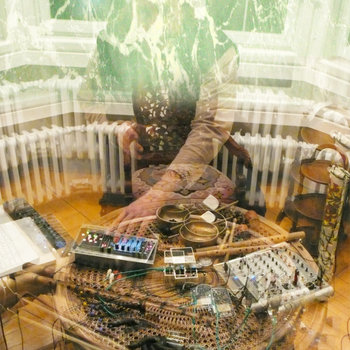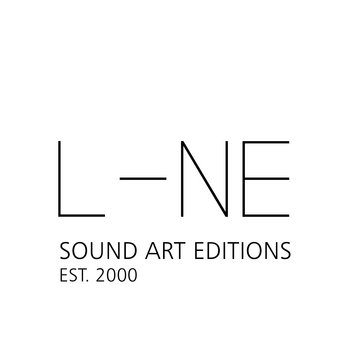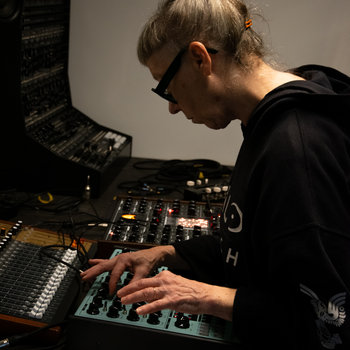
Pasadena sound artist Steve Roden, the composer most associated with the subset of minimal ambient music known as “lowercase,” characterizes it as music that “bears a certain sense of quiet and humility; it does not demand attention, it must be discovered. [The] work might imply one thing on the surface but contain other things beneath… it’s the opposite of capital letters—loud things which draw attention to themselves.”
Roden says he became interested in ambient music and silence in the late ‘70s “at age 14, when someone gave me a copy of Eno’s Another Green World.” He was also inspired by “a gift from an aunt who gave me a book of Rilke’s Letters To a Young Poet,” which had, he says, “a core of silence and humility.” In the mid ’80s, he was “making music in the punk scene as a singer, loud as hell, and very uppercase.” He eventually moved as far away from loud-and-fast as possible, but punk’s DIY approach stayed with him. “I never wanted to be famous, just find different ways to making, so that there would have to be surprises,” he says.
Lowercase’s other (often barely) audible precursors include classical minimalists like Webern and Morton Feldman, John Cage’s experiments with silence, and musique concrète. The genre also often includes elements of ambient field recordings and drones, but all of it is rooted in an attention to liminal detail, inviting the listener to scrutinize every last tiny instrumental event scattered throughout the background buzz. Here are some essential releases to get you started.

Steve Roden
sometime in the late 80s


The iconic two-CD compilation Lowercase, assembled by Josh Russell, was released in 2000, but the artists who appear on it—including Richard Chartier, Bernhard Günter, Jason Lescalleet, Taylor Deupree, Oren Ambarchi and, of course, Steve Roden— had all been active for some time before that. It’s a little difficult to figure out, then, when lowercase music started, or where to start learning about it—but the 36-minute Steve Roden track sometime in the late 80s seems like as good a place as any. Roden unearthed this recording in 2018 from a stack of unlabeled CD-Rs he’d made in the late ‘80s (as the title says). He believes it was created with contact mics and delay pedals; at one point you can hear a cough, at another what sounds like a car starting. There are pulses and whispers that are too abstract to even call static, and then Roden vocalizes quietly at the very end.
Richard Chartier and Taylor Deupree
spec.


Electronic musician Taylor Deupree and his influential record label, 12k, are both closely associated with the lowercase movement; so is minimalist Richard Chartier and his label LINE. The 1999 album spec., released on 12k in 1999, is a collaboration between Deupree and Chartier. The project sounds like Steve Reich at points, with the volume turned very low, as Deupree and Chartier curate repetitive pops in rhythmic bursts of powdery static. A lot of lowercase music is relaxing, but spec is more like an itch behind your eyes you can’t manage to scratch—an annoyance all the worse because it’s just below the pain threshold.
Bernhard Günter with Jeph Jerman
Buddha With The Sun Face / Buddha With The Moon Face
German minimalist composer Bernhard Günter is another influential lowercase figure. Buddha with the Sun Face/Buddha with the Moon Face was released in 1999 on his Trente Oiseaux label. It’s a collaboration with sound artist Jeph Jerman, who generally works with field recordings and non-musical objects. Together Günter and Jerman recorded and manipulated desert objects and noises to create 21 minutes of clicks, scrapes, pops, distant whistles, and occasional gurgles—most of which are impossible to hear without putting on headphones and cranking the track up to maximum volume. Lowercase doesn’t get much more lowercase.
Michael Northam
:Coyot


American sound artist Michael Northam, aka mnortham, creates layered, textured drones by meticulously arranging snippets and segments of field recordings. :Coyot was his first full-length solo album, based on recordings that Northam made over a week in 1998 on an island in Finland. Standout sounds heard on the record include Aeolian harp, a cannon barrel, and wind. Northam spent two years mixing the noises into a single droning whole in the studio. Rustlings and vibrations fade in and out and slide over each other against a quiet, endless, unavoidably spiritual hum.
Bernhard Günter
Then, Silence
Günter dedicates this 36-minute piece to classical composers Luigi Nono and Morton Feldman, and it’s more recognizable as music than a lot of more ambient lowercase recordings. The sounds Günter evokes deliberately suggest standard instruments—strings especially, but also piano and vocal chorus. Notes and drones slide from silence, creating melodic sketches that hover and then evaporate. It’s atmospheric enough that one could hear it as a film soundtrack, albeit a very, very sparse one.
Steve Roden
Forms of Paper


Steve Roden’s Forms of Paper, released on Richard Chartier’s LINE label in 2001, is probably the most famous lowercase release. It was originally a sound installation placed in the Hollywood Branch of the Los Angeles Public Library. Roden created the piece with contact mics and a book of German poems by Bertold Brecht. Roden rubbed the mics on the book, or rubbed the pages with his hands next to the mic. Even though hands and paper are organic, the sounds they made don’t sound like it; the 53-minute piece is all strobing clicks and quiet bleeps, like robots whispering to each other between the shelves.
Miki Yui
Lupe Luep Peul Epul

Compact Disc (CD)

Germany-based sound artist Miki Yui released Lupe Luep Peul Epul on LINE in 2001. The album was created by manipulating recorded sounds and organizing them into echoing, layered compositions. The mostly one- or two-minute tracks aren’t built on either silence or drones. Instead, they’re filled with echoes and ghosts of sounds, evoking transient memories.
Roel Meelkop
Momentum


Dutch composer Roel Meelkop has been creating sparse electronic soundscapes since the ‘80s; one of his compositions served as the first track on the aformentioned Lowercase compilation. The six tracks on Momentum are from, or adapted from, gallery sound installations he created between 1997 and 2004. “Am Birkenwald” sounds like a forest with frogs clicking, and perhaps an engine thrumming somewhere nearby, culminating in a cloudburst of static towards the close. On “Sub Version with High End,” deep tones alternate with painfully high-frequency squeaks and stabs, like some kind of extended hearing test.
Paulo Raposo and Marc Behrens
Further Consequences of Reinterpretation


In 2000, Japanese artist Nosei Sakata, aka *0, released a limited-edition CD titled 0.000, which consisted of nothing but silence. He then invited other artists—including German composer Marc Behrens, Taylor Deupree, Aube, Richard Chartier, Bernhard Günter and Steve Roden—to manipulate and add sounds to each track, creating a double-CD called Inflation (*0-0.000remix). Behrens then took that CD and collaborated with Portuguese artist Paulo Raposo to remix the remixes. The result is a crowded dialogue—20 tracks of clicks and beeps which, in the egoless lowercase manner, could have been generated by anyone.
Sawako
Hum


NYC/Tokyo artist Sawako’s Hum was released on 12k in 2005. It’s a carefully shaped combination of manipulated field recordings and instrumental and electronic additions by a handful of musicians, including the label’s founder, Taylor Deupree. The album is composed of soft, fragile sounds, like much of lowercase music. But it also has affinities with the poppier side of ambient—think Enya with less structure and the volume turned down.
I8U
10-33CM


Montreal-based minimalist composer France Jobin, aka I8U, released 10-33CM in 2009. The title refers to the supposed size of the strings of the universe, according to string theory, and accordingly, each track unfolds as a cosmic vibration. The album has some similarities with the work of mnortham, though 10-33CM is more delicate and crystalline, hovering between abstraction and New Age. Drones with barely varied overtones and undertones generate shimmering hints of melody.







